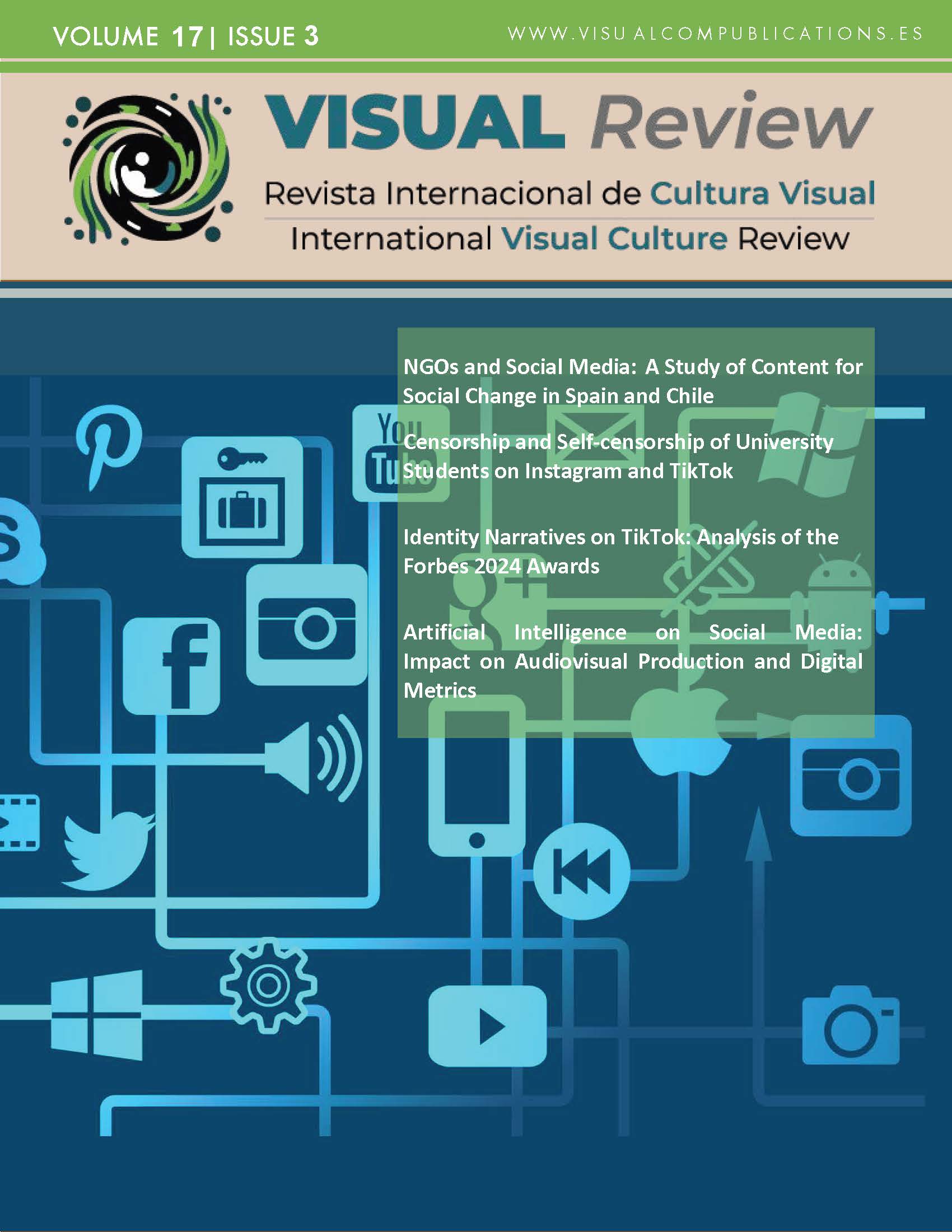Sustainable Fashion and Social Media
Inditex´s Strategy to Justify Premium Prices
DOI:
https://doi.org/10.62161/revvisual.v17.5783Keywords:
Sustainable Development Goals, Slow Fashion, Fast Fashion, Sustainability, Social MediaAbstract
The article analyzes the communication of Corporate Social Responsibility (CSR) in the fashion sector, with special focus on Inditex. The relationship between sustainability, consumer perception and communication strategy is examined, highlighting the role of social networks in the legitimization of business practices. Through an empirical study based on surveys and content analysis on networks, deficiencies in the visibility and effectiveness of Inditex's sustainable message are identified. The findings highlight the need to improve transparency and communication segmentation to strengthen consumer trust and their willingness to pay more for sustainable products.
Downloads
Global Statistics ℹ️
|
1087
Views
|
459
Downloads
|
|
1546
Total
|
|
References
Ali, R., García-Sánchez, I. M., Aibar-Guzmán, B., & Rehman, R. ur. (2024). Is biodiversity disclosure emerging as a key topic on the agenda of institutional investors? Business Strategy and the Environment, 33(3), 2116–2142. https://doi.org/10.1002/bse.3587 DOI: https://doi.org/10.1002/bse.3587
Alonso-Mosquera, M. H., Láiz, J. R., & Martín, M. S. (2024). Fast fashion and Sustainability: A Paradigm Shift in Marketing or Just a Greenwashing Strategy? European Public and Social Innovation Review, 9. https://doi.org/10.31637/epsir-2024-634 DOI: https://doi.org/10.31637/epsir-2024-634
Baena, V. (2024). The shift from fast fashion to socially and sustainable fast fashion: The pivotal role of ethical consideration of consumer intentions to purchase Zara. Corporate Social Responsibility and Environmental Management. https://doi.org/10.1002/csr.2803 DOI: https://doi.org/10.1002/csr.2803
Barbeito-Caamaño, A., & Chalmeta, R. (2020). Using big data to evaluate corporate social responsibility and sustainable development practices. Corporate Social Responsibility and Environmental Management, 27(6), 2831–2848. https://doi.org/10.1002/csr.2006 DOI: https://doi.org/10.1002/csr.2006
Blazquez, M., Henninger, C. E., Alexander, B., & Franquesa, C. (2020). Consumers’ Knowledge and Intentions towards Sustainability: A Spanish Fashion Perspective. Fashion Practice, 12(1), 34–54. https://doi.org/10.1080/17569370.2019.1669326 DOI: https://doi.org/10.1080/17569370.2019.1669326
Castillo-Abdul, B., Romero-Rodríguez, L. M., & Erika-Lucia, G.-C. (2020). Comportamiento del mercado digital respecto a la moda sostenible: Estudio de caso de influencers españolas. Revista Venezolana de Gerencia, 1559–1582. https://doi.org/10.37960/rvg.v25i92.34281 DOI: https://doi.org/10.37960/rvg.v25i92.34281
Cristófol Rodríguez, C., Mcquillan, K., & Segarra-Saaavedra, J. (2021). La comunicación de la sostenibilidad como herramienta de ventas y de cambio social: fast fashion vs slow fashion. Revista de Comunicación de La SEECI, 54, 17–37. https://doi.org/10.15198/seeci.2021.54.e667 DOI: https://doi.org/10.15198/seeci.2021.54.e667
Cristófol-Rodríguez, C., Villena-Alarcón, E., & Cerdá-Suárez, L. M. (2024). Un estudio de la sostenibilidad en las empresas de moda españolas a través de los estándares GRI. European Public & Social Innovation Review, 9, 1–20. https://doi.org/10.31637/epsir-2024-1105 DOI: https://doi.org/10.31637/epsir-2024-1105
DIRCOM (2024). (2024). ODS18 El derecho a entender. Https://Ods18comunicacion.Com/#intro .
Directiva (UE) 2024/825 Del Parlamento Europeo y Del Consejo de 28 de Febrero de 2024, https://eur-lex.europa.eu/legal-content/ES/TXT/?uri=OJ%3AL_202400825 (2024).
Esbeih, K. N., Molina-Moreno, V., Núñez-Cacho, P., & Silva-Santos, B. (2021). Transition to the circular economy in the fashion industry: The case of the inditex family business. Sustainability (Switzerland), 13(18). https://doi.org/10.3390/su131810202 DOI: https://doi.org/10.3390/su131810202
Escamilla Solano, S., Plaza Casado, P., & Flores Ureba, S. (2016). Analysis of the disclosure of information on corporate social responsibility in urban public transport companies in Spain. Revista de Contabilidad-Spanish Accounting Review, 19(2), 195–203. https://doi.org/10.1016/j.rcsar.2015.05.002 DOI: https://doi.org/10.1016/j.rcsar.2015.05.002
Escamilla-Solano, S., Fernández-Portillo, A., Paule-Vianez, J., & Plaza-Casado, P. (2019). Effect of the disclosure of corporate social responsibility on business profitability. A dimensional analysis in the Spanish stock market. Sustainability (Switzerland), 11(23). https://doi.org/10.3390/su11236732 DOI: https://doi.org/10.3390/su11236732
Estanyol, E. (2020). Communicating corporate social responsibility (Csr): An analysis of the most award-winning campaigns of 2018. Profesional de La Informacion, 29(3), 1–13. https://doi.org/10.3145/epi.2020.may.34 DOI: https://doi.org/10.3145/epi.2020.may.34
Galán Cubillo. (2024). Objetivos de desarrollo sostenible, comunicación y empresas Apellidos, nombre. http://hdl.handle.net/10251/204720
Galan-Ladero, M. M., & Sánchez-Hernández, M. I. (2022). Corporate donation behavior during the covid-19 pandemic. A case-study approach in the multinational inditex. Heliyon, 8(12). https://doi.org/10.1016/j.heliyon.2022.e12188 DOI: https://doi.org/10.1016/j.heliyon.2022.e12188
Gálvez-Sánchez, F. J., Molina-Prados, A., Molina-Moreno, V., & Moral-Cuadra, S. (2024). Exploring the three-dimensional effect of corporate social responsibility on brand equity, corporate reputation, and willingness to pay. A study of the fashion industry. Journal of Retailing and Consumer Services, 79, 103836. https://doi.org/10.1016/J.JRETCONSER.2024.103836 DOI: https://doi.org/10.1016/j.jretconser.2024.103836
García-Huguet, L. (2021). Online CSR communication on environmental responsibility. The case of fast fashion and slow fashion companies. Fonseca Journal of Communication, 22, 57–79. https://doi.org/10.14201/fjc-v22-22664 DOI: https://doi.org/10.14201/fjc-v22-22664
Garcia-Ortega, B., Galan-Cubillo, J., Llorens-Montes, F. J., & de-Miguel-Molina, B. (2023). Sufficient consumption as a missing link toward sustainability: The case of fast fashion. Journal of Cleaner Production, 399, 136678. DOI: https://doi.org/10.1016/j.jclepro.2023.136678
García-Sánchez, I.-M., Aibar-Guzmán, B., Aibar-Guzmán, C., & Rodríguez-Ariza, L. (2020). “Sell” recommendations by analysts in response to business communication strategies concerning the Sustainable Development Goals and the SDG compass. Journal of Cleaner Production, 255, 120194. https://doi.org/10.1016/j.jclepro.2020.120194 DOI: https://doi.org/10.1016/j.jclepro.2020.120194
Gasper, D., Shah, A., & Tankha, S. (2019). The Framing of Sustainable Consumption and Production in SDG 12. Global Policy, 10(S1), 83–95. https://doi.org/10.1111/1758-5899.12592 DOI: https://doi.org/10.1111/1758-5899.12592
López Pérez, C. (2018). Comunicación y sentimientos desde la Teoría de Sistemas Sociales de Niklas Luhmann. Sociológica (México), 33(93), 53–86.
Luhmann, N. (1998). Sistemas sociales: lineamientos para una teoría general (Vol. 15). Anthropos editorial.
Marcuello Servos, C., & Marcuello, C. (2007). NGOs, corporate social responsibility, and social accountability: Inditex vs. Clean Clothes. Development in Practice, 17(3), 393–403. https://doi.org/10.1080/09614520701336972 DOI: https://doi.org/10.1080/09614520701336972
Marín, N. C. G., Arriciaga, R. V. G., Estrada, J. C., & Sumba, N. (2024). Influencer marketing and its impact on customer purchase decisions in the fashion and beauty industry in Ecuador. Doxa Comunicacion, 2024(38), 207–226. https://doi.org/10.31921/doxacom.n38a1993 DOI: https://doi.org/10.31921/doxacom.n38a1993
Martín López, R. (2019). Comunicación de la sostenibilidad de las principales marcas de fast fashion españolas e italianas: Zara, Mango, Calzedonia y OVS. Diferencias entre el punto de venta online y el punto de venta físico. AdComunica, 123–154. https://raco.cat/index.php/adComunica/article/view/365731. DOI: https://doi.org/10.6035/2174-0992.2019.18.8
Modaes & KPMG. (2022). global-fashion-drivers-2022. https://acortar.link/Kf0U8m
Monfort, A., & Mas Iglesias, J. M. (2021). Barreras y oportunidades para la comunicación de la responsabilidad social en redes sociales. Comunicación y Hombre, 17, 349–361. https://doi.org/10.32466/eufv-cyh.2021.17.645.349-361 DOI: https://doi.org/10.32466/eufv-cyh.2021.17.645.349-361
Pereira, M. J. de S., Cardoso, A., Canavarro, A., Figueiredo, J., & Garcia, J. E. (2023). Digital Influencers’ Attributes and Perceived Characterizations and Their Impact on Purchase Intentions. Sustainability (Switzerland), 15(17). https://doi.org/10.3390/su151712750 DOI: https://doi.org/10.3390/su151712750
Pérez Santos, L., & Pérez Hernansanz, L. (2022). La estrategia comunicativa de Inditex en TikTok. Análisis de cuatro marcas: Zara, Massimo Dutti, Bershka y Pull&Bear.
Quiles-Soler, C., Martínez-Sala, A. M., & Monserrat-Gauchi, J. (2023). Fashion industry’s environmental policy: Social media and corporate website as vehicles for communicating corporate social responsibility. Corporate Social Responsibility and Environmental Management, 30(1), 180–191. https://doi.org/10.1002/csr.2347 DOI: https://doi.org/10.1002/csr.2347
Ramírez Barredo, B., & Guerrero González-Valerio, B. (2024). Responsabilidad social corporativa, criterios ESG y su comunicación en el sector textil español. European Public & Social Innovation Review, 9, 1–20. https://doi.org/10.31637/epsir-2024-897 DOI: https://doi.org/10.31637/epsir-2024-897
Regadera González, E. (2023). La comunicación de la colección Join Life en tiendas físicas de Zara Barcelona (2022), etiquetas y ficha de producto web. Revista Panamericana de Comunicación, 5(1), 32–50. https://doi.org/10.21555/rpc.v5i1.2865 DOI: https://doi.org/10.21555/rpc.v5i1.2865
Reverte, C. (1995). Determinants of Corporate Social Responsibility Disclosure Ratings by Spanish Listed Firms. In Journal of International Finan-cial Management and Accounting (Vol. 8, Issue 2). Cormier and Magnan.
SDG Compass. (2024). La guía para la acción empresarial en los ODS. Https://Sdgcompass.Org/Wpcontent/ Uploads/2016/06/SDG_Compass_Spanish-One-Pager-View.Pdf .
Sullivan, K., Thomas, S., & Rosano, M. (2018). Using industrial ecology and strategic management concepts to pursue the Sustainable Development Goals. Journal of Cleaner Production, 174, 237–246. https://doi.org/10.1016/j.jclepro.2017.10.201 DOI: https://doi.org/10.1016/j.jclepro.2017.10.201
Thorisdottir, T. S., & Johannsdottir, L. (2020). Corporate social responsibility influencing sustainability within the fashion industry. A systematic review. In Sustainability (Switzerland) (Vol. 12, Issue 21, pp. 1–64). MDPI. https://doi.org/10.3390/su12219167 DOI: https://doi.org/10.3390/su12219167
Downloads
Published
How to Cite
Issue
Section
License
Copyright (c) 2025 Authors retain copyright and transfer to the journal the right of first publication and publishing rights

This work is licensed under a Creative Commons Attribution-NoDerivatives 4.0 International License.
Those authors who publish in this journal accept the following terms:
-
Authors retain copyright.
-
Authors transfer to the journal the right of first publication. The journal also owns the publishing rights.
-
All published contents are governed by an Attribution-NoDerivatives 4.0 International License.
Access the informative version and legal text of the license. By virtue of this, third parties are allowed to use what is published as long as they mention the authorship of the work and the first publication in this journal. If you transform the material, you may not distribute the modified work. -
Authors may make other independent and additional contractual arrangements for non-exclusive distribution of the version of the article published in this journal (e.g., inclusion in an institutional repository or publication in a book) as long as they clearly indicate that the work was first published in this journal.
- Authors are allowed and recommended to publish their work on the Internet (for example on institutional and personal websites), following the publication of, and referencing the journal, as this could lead to constructive exchanges and a more extensive and quick circulation of published works (see The Effect of Open Access).













